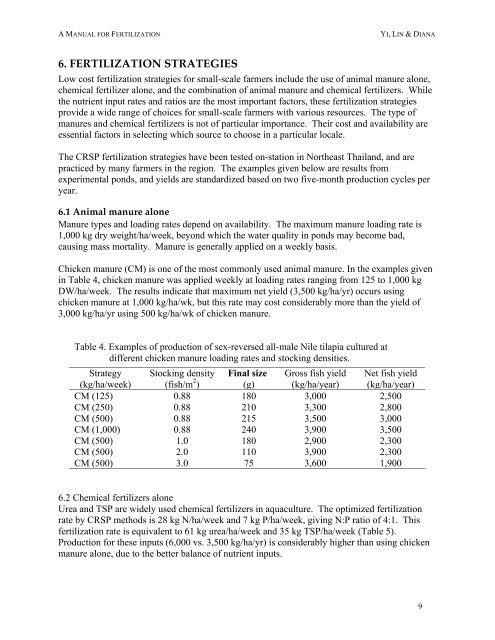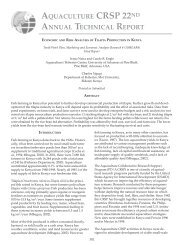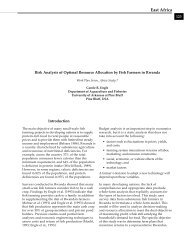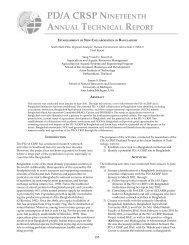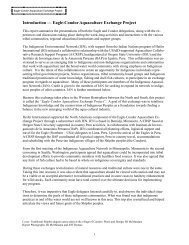manual of fertilization and supplemental feeding strategies
manual of fertilization and supplemental feeding strategies
manual of fertilization and supplemental feeding strategies
Create successful ePaper yourself
Turn your PDF publications into a flip-book with our unique Google optimized e-Paper software.
A MANUAL FOR FERTILIZATION YI, LIN & DIANA<br />
6. FERTILIZATION STRATEGIES<br />
Low cost <strong>fertilization</strong> <strong>strategies</strong> for small-scale farmers include the use <strong>of</strong> animal manure alone,<br />
chemical fertilizer alone, <strong>and</strong> the combination <strong>of</strong> animal manure <strong>and</strong> chemical fertilizers. While<br />
the nutrient input rates <strong>and</strong> ratios are the most important factors, these <strong>fertilization</strong> <strong>strategies</strong><br />
provide a wide range <strong>of</strong> choices for small-scale farmers with various resources. The type <strong>of</strong><br />
manures <strong>and</strong> chemical fertilizers is not <strong>of</strong> particular importance. Their cost <strong>and</strong> availability are<br />
essential factors in selecting which source to choose in a particular locale.<br />
The CRSP <strong>fertilization</strong> <strong>strategies</strong> have been tested on-station in Northeast Thail<strong>and</strong>, <strong>and</strong> are<br />
practiced by many farmers in the region. The examples given below are results from<br />
experimental ponds, <strong>and</strong> yields are st<strong>and</strong>ardized based on two five-month production cycles per<br />
year.<br />
6.1 Animal manure alone<br />
Manure types <strong>and</strong> loading rates depend on availability. The maximum manure loading rate is<br />
1,000 kg dry weight/ha/week, beyond which the water quality in ponds may become bad,<br />
causing mass mortality. Manure is generally applied on a weekly basis.<br />
Chicken manure (CM) is one <strong>of</strong> the most commonly used animal manure. In the examples given<br />
in Table 4, chicken manure was applied weekly at loading rates ranging from 125 to 1,000 kg<br />
DW/ha/week. The results indicate that maximum net yield (3,500 kg/ha/yr) occurs using<br />
chicken manure at 1,000 kg/ha/wk, but this rate may cost considerably more than the yield <strong>of</strong><br />
3,000 kg/ha/yr using 500 kg/ha/wk <strong>of</strong> chicken manure.<br />
Table 4. Examples <strong>of</strong> production <strong>of</strong> sex-reversed all-male Nile tilapia cultured at<br />
different chicken manure loading rates <strong>and</strong> stocking densities.<br />
Strategy Stocking density<br />
(kg/ha/week) (fish/m 2 Final size Gross fish yield Net fish yield<br />
) (g) (kg/ha/year) (kg/ha/year)<br />
CM (125) 0.88 180 3,000 2,500<br />
CM (250) 0.88 210 3,300 2,800<br />
CM (500) 0.88 215 3,500 3,000<br />
CM (1,000) 0.88 240 3,900 3,500<br />
CM (500) 1.0 180 2,900 2,300<br />
CM (500) 2.0 110 3,900 2,300<br />
CM (500) 3.0 75 3,600 1,900<br />
6.2 Chemical fertilizers alone<br />
Urea <strong>and</strong> TSP are widely used chemical fertilizers in aquaculture. The optimized <strong>fertilization</strong><br />
rate by CRSP methods is 28 kg N/ha/week <strong>and</strong> 7 kg P/ha/week, giving N:P ratio <strong>of</strong> 4:1. This<br />
<strong>fertilization</strong> rate is equivalent to 61 kg urea/ha/week <strong>and</strong> 35 kg TSP/ha/week (Table 5).<br />
Production for these inputs (6,000 vs. 3,500 kg/ha/yr) is considerably higher than using chicken<br />
manure alone, due to the better balance <strong>of</strong> nutrient inputs.<br />
9


